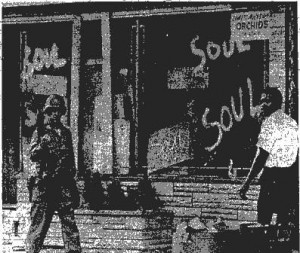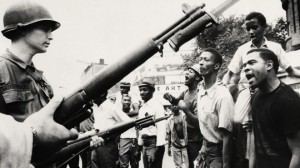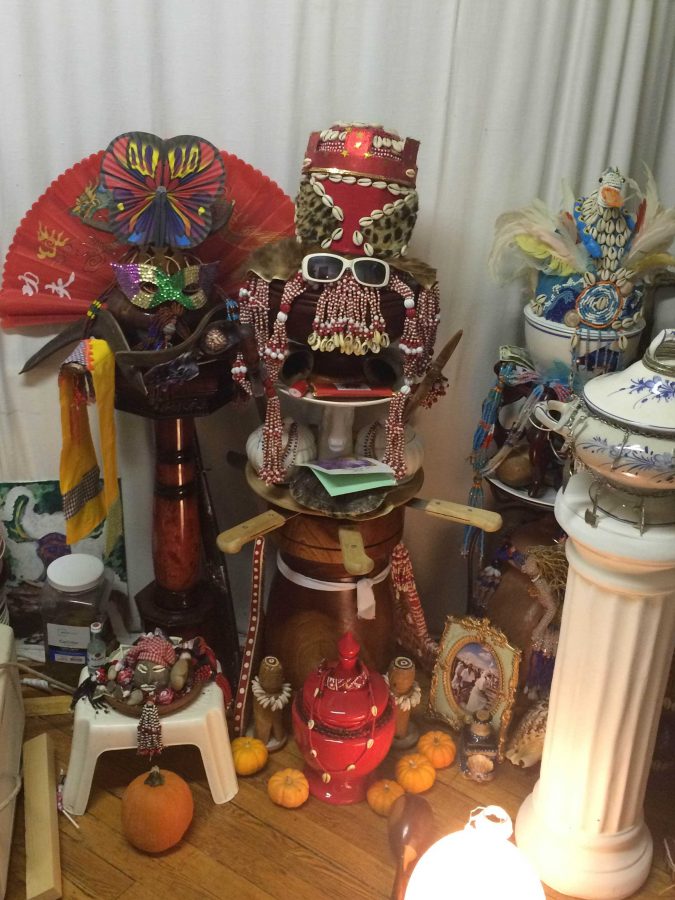I always find a seat on this train and never fall asleep because the ride is too short to provoke this. The man sitting to my right is falling asleep on me! Should I just softly push him to the other side? See, this is the problem when I sit on the train, I always run into someone that wants to pass out on top of my shoulder or have some older lady that wants to take up two seats – one for her and one for her bags. Although my ride is entertaining, arriving to Newark Penn Station can be overwhelming for those who aren’t familiar with the many entrances and exits, but this has been my commute since I was fourteen and I know it pretty well. I like to see all the different faces, I like taking the Light Rail to Bloomfield Avenue because it brings back all sorts of memories. Good and bad. Today’s visit in Newark is not for a family visit but to see Newark through other eyes.
 It was hot, uncomfortably humid, frustration circulated the city and all you see is the thick smoke in the air. Bricks are being thrown at police and elderly whites are being beaten to the ground. Bam! Bam! Bam! “Hold your fire. You’re firing at your own men, hollered a policeman to the State Troopers. Shots were being fired throughout Newark’s central ward and all you saw were civilians running, dodging bullets, fighting back and looting. Springfield Avenue, 17th Street, South Orange Avenue and Bergen Street are trashed with piles of debris, garbage, food, fires and broken glass. People are so angry that they are running up and down the streets looting businesses and taking clothes, food and socks. “…A lot of young people had no viable options or alternatives, there was no way of getting what you wanted through legitimate means and so if the opportunity presents itself for somebody to, if a store is broken into when they want a pair of sneakers, if they want a pair of jeans or a television set under those circumstances our moral judgments get suspended and people simply go after those things that they have been denied…” says Professor Max Herman from the Sociology department in New Jersey City University. Business store fronts read “Soul” or “Soul Brother” to be protected from rioters but, that didn’t stop what was about to come.
It was hot, uncomfortably humid, frustration circulated the city and all you see is the thick smoke in the air. Bricks are being thrown at police and elderly whites are being beaten to the ground. Bam! Bam! Bam! “Hold your fire. You’re firing at your own men, hollered a policeman to the State Troopers. Shots were being fired throughout Newark’s central ward and all you saw were civilians running, dodging bullets, fighting back and looting. Springfield Avenue, 17th Street, South Orange Avenue and Bergen Street are trashed with piles of debris, garbage, food, fires and broken glass. People are so angry that they are running up and down the streets looting businesses and taking clothes, food and socks. “…A lot of young people had no viable options or alternatives, there was no way of getting what you wanted through legitimate means and so if the opportunity presents itself for somebody to, if a store is broken into when they want a pair of sneakers, if they want a pair of jeans or a television set under those circumstances our moral judgments get suspended and people simply go after those things that they have been denied…” says Professor Max Herman from the Sociology department in New Jersey City University. Business store fronts read “Soul” or “Soul Brother” to be protected from rioters but, that didn’t stop what was about to come.
For the next five days the central ward district of Newark became a killing zone and twenty-six people would end up dead including two white men and a ten year old boy that was shot in the head by a National Guardsman. While protestors were being shot at by the State troopers and National Guardsmen there were stories about black snipers surrounding the area. If black snipers were looking to kill, then what happen to their shooting target expertise and their training skills? Was this a false story to justify the police shooting or were these untrained “snipers” to blame? According to Dr. Clement A. Price, History Professor at Rutgers University, “it’s a mythology surrounding black snipers because there was no arrest… it was fiction by the police or media.” Hundreds were injured, 1,500 arrested and the city faced $10 million dollars in damages. Unfortunately, as of today no one has been held accountable for these deaths.
In 1983, sixteen years after the 1967 Newark riots, both my parents settled in North Newark from San Sebastian, Puerto Rico and this is not the Newark that neither of my parents recall. I only remember Newark between the ages of five to ten and now as an adult. But one thing I am sure of is that we all remember Newark differently.
 Forty-four years earlier on July 12, 1967, one of the most memorable communal riots took place in the Central ward district in Newark, New Jersey. One hundred twenty-five cities experienced riots in 1967 but Newark and Detroit riots were the worst. The Newark riot that began on the summer night of July 12, 1967 was a night that would leave the city of Newark scarred, with a bad name and neglected for many years to come. To others this was not a riot, this was a rebellion bound to happen.
Forty-four years earlier on July 12, 1967, one of the most memorable communal riots took place in the Central ward district in Newark, New Jersey. One hundred twenty-five cities experienced riots in 1967 but Newark and Detroit riots were the worst. The Newark riot that began on the summer night of July 12, 1967 was a night that would leave the city of Newark scarred, with a bad name and neglected for many years to come. To others this was not a riot, this was a rebellion bound to happen.
The night was hot and humid and about 200 enraged local residents came together in front of the 4th police precinct on 17th Street due to a rumor of police brutality between a black cab driver, John Smith and two white police officers, John DeSimone and Vito Pontrelli. Smith was stopped by police on 7th Street and 15th Avenue because he had passed the cops but both cops claimed that the stop was a routine traffic stop. Smith was taken into police custody and witnesses said that they saw Smith being dragged into the precinct. As rumors traveled down the streets that Smith was beaten to death by police, many residents’ especially young black men reacted. A lot of the protestors came from the Hayes Homes projects, ten 12-story high rise buildings which were built back in 1954 on 5.5 acres.
Approximately 200 people were shouting “police brutality” in front of the precinct and demanded to see Smith and have him sent to the hospital, and he was. On July 13th a crowd of 400 people stood on 17th Avenue and Boyd Street throwing stones at buildings and by July 14th the streets got ugly and local police were given orders to defend themselves with firearms.
During the 1960’s, the Civil Rights Movement was taking place throughout Southern States, but it didn’t exclude the Northern states from racial discrimination. Before the Smith case triggered the Newark riot or rebellion, many things had been happening in the city that would create uproar within the African-American community. African-Americans and other minorities wanted to know who was to blame and why was nothing being done?
Two years prior to 1967 three black men died under police supervision and absolutely nothing was done about it by the mayor’s office. Hugh Addonizio, the white mayor at the time, in the predominantly black city of Newark was thought to be preventing blacks from moving forward in the work force and many residents felt discriminated against, oppressed and left out of important political issues. Addonizio’s plan to build the University of Medicine and Dentistry of New Jersey upset residents by not giving them a chance to express how they felt about this project. They also believed this was a strategy to force the poor out of the Hayes Homes projects because the plan was to tear down the projects and build the University on “their” homes. Another matter that concerned the African-American community was when Addonizio elected a white man with high school education over a black man with a college degree for Secretary of the School Board. The community also complained that the Newark Police Department was dominated by whites by only having 145 blacks out of 1,322 police officers. This just created higher unemployment rates, poverty and lack of employment opportunities.
After 1967 the city of Newark had declined and affected many lives. Many of the victims’ families have never recovered from the riots and many have moved to other cities because all Newark would be is a constant reminder of their loss. Many feel that this day should be recognized and “the riots should be seen as a day we remember…a day in which we mourn,” says Dr. Price. You’d think that residents would fight to have the 4th Police precinct torn down because of the bad reminders but on the contrary, many say it should be preserved because it played an important role.
Click here for more on Emergency Service Unit in Jersey City
Regardless of what people speculate about the city of Newark it is slowly but surely developing. After tearing down the Hayes Homes in the 90’s the city has created modern low income housing units. The New Jersey Performing Arts Center (NJ PAC), Bears & Eagles Riverfront Stadium, 50 acre University Heights Science Park, FBI New Jersey Headquarters and the Newark Arena are positive developments that create revenue and employment for Newarkers. Needless to say, it does not mean that there is never a possibility that history cannot repeat itself due to the changes in our economy or the changes in demographics. But having a riot-free city can be a symbol of finally reaching equality, peace and unity.






Evelyn • Dec 26, 2011 at 2:03 am
Awesome article!! Learned some history about Newark, NJ. Very interesting as one only thinks about the southern civil rights movement, happy to see progress for all and hopefuly one day without discrimination to race, gender or social class! Congrats on a wonderful article!